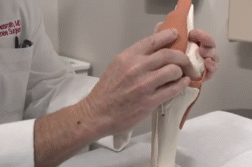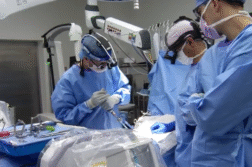SAN DIEGO, Calif. (Ivanhoe Newswire) – Whether you’re a weekend warrior, amateur athlete, or pro, tearing your anterior cruciate ligament, or ACL, can sideline you for several months, possibly even a year. Nearly 200,000 ACL reconstruction surgeries are performed in the U.S. each year, and now, there’s a new less invasive treatment option that can get athletes back in the game faster than ever before. Marshmallow Implant
With every leg lift, Jenna Richardson is one step closer to getting back to the things she loves.
“About every other weekend, we fly all over the world to ski. I love to surf and we travel all around the world for that, too,” Jenna mentions.
But it was the last run of the day on her mountain bike that stopped her in her tracks.
“I was riding down a big rock and the back of the bike kind of flew around to the front of the bike. My front tire got stuck and my knee went with it,” Jenna remembers.
It completely tore her ACL, which is a band of tissue that runs through the center of the knee. In the past, orthopedic surgeon at the San Diego, California Scripps Clinic, Dr. Tim Wang, MD, would need to build a new ACL from tissue from the patient’s other healthy knee, or cadaver tissue, requiring two surgical sites. But now, this tiny implant is repairing ligaments from the inside out in one procedure.
“This is one of the first times that we’re able to repair somebody’s own ACL and support it as it heals with a collagen sponge,” Dr. Wang says.
Through a tiny incision, surgeons stitch the ligaments together, then insert the bridge-enhanced ACL repair, or BEAR, implant between the torn ligaments.
Dr. Wang explains, “It’s about the size of a marshmallow and we soak it and load it with the patient’s own blood and insert that into the knee through a small incision.”
The collagen helps to heal the gap between the two ends of the ruptured ligament. The patient’s body absorbs the implant material within a few months.
Just a few weeks out from surgery, Jenna is hoping to lose her crutches soon and hopes to get back doing what she loves.
Benefits include a less invasive single site surgery, less time in the operating room, shorter healing time and recovery. The BEAR implant is the only device cleared by the FDA for ACL restoration. You must be at least 14 years old, with a complete rupture of the ACL, and it must be implanted within 50 days of the injury. Nationwide, 100 surgeons in 26 states are performing the BEAR procedure.
Contributors to this news report include: Marsha Lewis, Producer; Roque Correa, Videographer & Editor.
To receive a free weekly e-mail on medical breakthroughs from Ivanhoe, sign up at: http://www.ivanhoe.com/ftk
MEDICAL BREAKTHROUGHS
RESEARCH SUMMARY
TOPIC: MARSHMALLOW IMPLANT HEALS ACL FROM THE INSIDE OUT
REPORT: MB #5144
BACKGROUND: Treatments for ACL injuries historically have required a surgical reconstruction of the ligament with gathered tissues. ACL injuries are common among basketball, football, and other athetes. The ACL is our knee’s bone structure that is made of three parts. The femur, tibia, and patella. The stability of the ACL is extremely important in fast paced sports due to the requirement of constant pivoting of joints. An injury of the ACL can bring your career to a fast stop. These injuries can occur no matter the age or intensity level of the sport. They commonly happen when two players collide. The injury can range from a sprain to an entire rupture of the ligament. Sprains and partial tears are often missed and can worsen over time causing severe and permanent damage.
(Sources:
DIAGNOSING: When diagnosing an ACL injury, the doctor will need to know how the knee was injured. Most injuries occur from constant pivoting in high interval sports. The doctor compares the injured area to the opposing healthier area. Pain and impermanence can occur either directly after the injury, or not until weeks following. Doctors will sometimes require further x-rays to detect more bone injuries. MRI scans allow better photo and detection to diagnose the severity of the injury. Half of patients who injured their ACL, have also injured another part of their knee.
(Source:
NEW TECHNOLOGY: New treatment options are showing a no longer need to harvest replacement tissues. New findings are suggesting the encouragement of growing torn ACL back together. The procedure uses a cylindrical marshmallow injected with the patient’s blood to heal the area.
(Source:
FOR MORE INFORMATION ON THIS REPORT, PLEASE CONTACT:
Stephen Carpowich
Carpowich.stephen@scrippshealth.org
If this story or any other Ivanhoe story has impacted your life or prompted you or someone you know to seek or change treatments, please let us know by contacting Marjorie Bekaert Thomas at mthomas@ivanhoe.com




